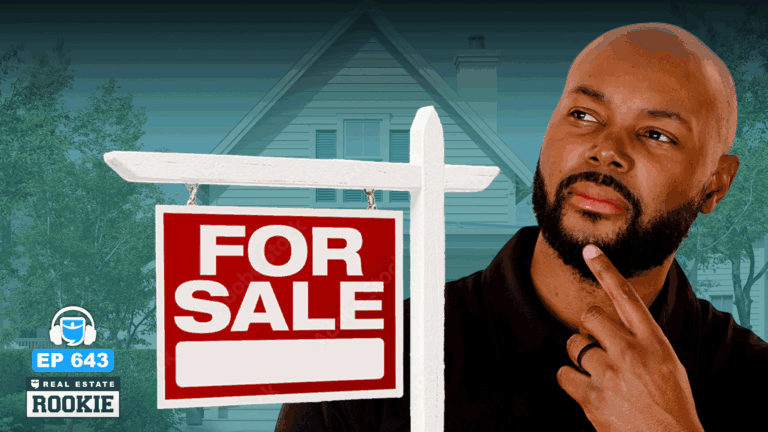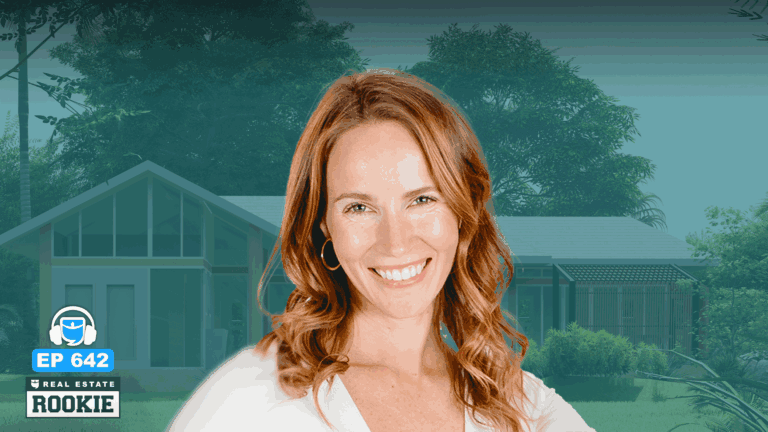Dave:
The housing market is hitting its typical seasonal slowdown. Listings are tapering off. Price growth is definitely flattening and mortgage demand has stalled for the fourth straight week, but under the surface, investors are positioning what’s next and starting to look forward to 2026. I’m Dave Meyer, alongside Kathy Fettke, Henry Washington and James Dainard, and today we’re walking through the headlines and trends that are shaping the end of 2025 you’re listening to On the Market. Let’s jump in. James, Kathy Henry, thank you all so much for being here. Kathy, how are you?
Kathy:
I’m doing great. I am here in Phoenix. I’m going to stalk James later. Going to go find where he lives.
Dave:
I mean, just look for the biggest house in the city and you’ll find him. James, how are you doing?
James:
I’m doing good, man. It’s nice and sunny here. We have four more weeks of shooting. We have to complete nine houses. Three of ’em are in studs, so we’ll see what happens.
Dave:
That’s unbelievable. Wow, Henry, I hope your life is a little simpler than that.
Henry:
Yeah, I have to complete five projects, but I don’t have a timeframe. I just have to pay holding costs if I don’t go fast.
Dave:
Yeah, there’s no TV crew chasing you down right now,
Henry:
Correct?
Dave:
Well, we got a lot to talk about today. Thank you guys all for being here. We are entering sort of the last stages of 2025, but at least to me it really feels like housing has come into focus, especially housing affordability. In the last couple of weeks it’s been in the news, it was definitely a major part of the elections that went on the other couple of days. So we’ll talk a little bit about housing affordability and some ideas to improve it. We’ll talk about recent trends in the housing market, of course, how margins are being impacted by recent cost increase and how the job market is developing and actually what it means that might be positive for real estate investors. So let’s jump in Kathy Europe first, bring us your headline.
Kathy:
Okay, well, mine is from Yahoo Finance and it is Trump administration is evaluating portable mortgages and what that means for homeowners. I had to look up what in the world portable mortgages are, and I was a mortgage broker for years,
Dave:
So it sounds cool.
Kathy:
Yeah, I had never heard of it. I’m like, well, okay, it kind of makes sense. You carry it with you, and I thought, okay, this is granted. The Trump administration is no stone unturned in terms of trying to figure out how to unlock the housing market.
Speaker 5:
We
Kathy:
Know obviously home prices are defined gravity, even with high rates, even with wage growth slowing even with inflation, the prices just keep going up and not everywhere. Not everywhere, but nationally. And of course we have so many people locked into lower payments that don’t want to leave that, so it’s like how do you unlock this housing market? They floated the idea of the 50 year mortgage. Of course that was headline news for a while and there was a lot of backlash because again, having been a mortgage broker for the first years that you’re paying your loan, you’re really not paying down your loan anyway. You’re paying interest only for the most part for the first year. So most people sell I think within 10 years,
So it doesn’t matter that much. But what does matter is that 50 year mortgages tend to be higher costs, so it doesn’t really, I mean we don’t have 50 year mortgages, but 30 year fixed rate mortgages are higher than shorter term. So the idea would be a 50 year would be higher price. So then this idea came out, there was backlash. How about the portable mortgage? And apparently this is something they do in Canada and the uk it is not new. I thought it was just something they dreamed up in a boardroom, but it’s actually been done. But the difference is that in Canada, in the uk, they’re shorter term loans, so I suppose it’s different than a 30 year term where you can carry it from house to house with you. But I love the concept and it would be amazing. I have a low interest rate and I think it would be fun to carry it to another property.
Henry:
I have a 2.3% interest rate and I would carry this thing with me for the rest of my life. Are you kidding me?
Dave:
But is that the idea that you could keep your current one at a 30 year and make it portable or is it that new mortgages would be portable?
Kathy:
It sounded like they’re just talking about any possibility. Right, okay. They’re
Henry:
Trying to reverse the lock-in effect. So they’re saying, what if we could stimulate the economy by people buying houses, if they can take their low interest rates with them, and so it would be, it’s my understanding that it would be for people who currently have mortgages, not just new mortgages.
Dave:
Okay. I have thoughts about this. I mean, I actually think it’s an interesting idea. I kind of like the idea, how does that work because all of these mortgages have already been originated packaged and sold to investors. Those investors aren’t going to then agree retroactively to change the terms of the loan. Is this even that just doesn’t make sense.
Kathy:
Yeah, I mean it sounds like the state of Maine floated mortgage portability legislation in 2025, so it’s not just the Trump administration that’s been talked about because it actually does exist in other countries,
Dave:
But I get that it exists in other countries, but it exists at the point of an origination. So the fees and the interest rate and the bank already know are all factored into that. If I was the owner of those mortgage backed securities, I’d be like, I don’t know if I want that to just be portable going forward.
Kathy:
Well, it seems like they would have to underwrite the new property. They’d have to make sure it’s a similar situation because probably the people who have the mortgages that would be portable that they’d want to take with them have a ton of equity, so very low risk. So would they have that same amount of equity? Maybe just the whole thing moves like a 10 31,
Dave:
But the banks don’t want this. They want them to refi at a higher interest rate. Absolutely. They don’t want to be carrying ten’s 2.3% interest rate for the next 27 years.
James:
If someone can pull off negotiating that deal, I’m hiring them. That is the ultimate negotiator. I mean, yeah, why would they do that? So they do it in Canada, you said are their rates way higher there
Dave:
And they’re only three year terms or five year terms,
James:
So that makes sense, right? Yes, the bank shares upside or they share risk in that or they can mitigate, but on a fixed, I’m not buying Henry’s loan for
Dave:
2.25. Exactly. No one’s buying that. So it sounds like a good idea, but hard to imagine it happening.
Kathy:
The fact that we can even lock in 30 year fixed rate loans is amazing and then that we could do it at two and 3% is also amazing. What bank would ever agree to that? I don’t know. They did, but what was also interesting about this article that I forgot is consumable mortgages are a thing and they are a thing on FHA loans, on VA loans and USDA loans. So this article kind of says go look for those. That’s a great strategy.
Dave:
Those are amazing. If you can find an consumable mortgage, you should absolutely look for those. I should just note that those are only available for owner occupants and my guess is if somehow they miraculously pull off this portable mortgage idea, it would also only be available for owner occupants. I don’t think this is about to be an investor loan.
Henry:
For the record, I asked Chad GPT, what would mortgage securities holder, why would they sign up for this or what makes it good for them? And it basically said absolutely nothing.
Dave:
Yeah, nothing. Yeah, there’s no reason,
Which honestly could backfire because if you do stuff to upset the MBS market, they’re just going to demand higher rates for current mortgages to compensate for that. So it just doesn’t make sense retroactively, if they started introducing this as a new loan product moving forward, I think that would be cool. I know now I’m super stoked about that in terms of their rates, but just if a homeowner, if you were moving, it’s just easier. You get to keep your amortization schedule, it’s better for you for building equity. So I mean I would be interested in introducing it now. I just don’t think it could reasonably happen looking backwards. Alright, well interesting idea. I mean the way I feel about this, we put out an episode on the market where I was just rambling about 50 or mortgages and I just want to say I’m not opposed to short-term solutions that help the housing market, but I just don’t like ones that make the long-term solution further out. That’s kind of how I feel about the 50 year mortgage is like I get lowering the payment $200 a month for the average home could be meaningful to some people, but it’s actually just going to make affordability challenges worse instead of actually making homes more affordable, which is what actually needs to happen.
And so I think that’s not going to work. I unfortunately don’t think portable mortgages are really going to work for long-term solutions, but I hope as they’re trying to figure this out, they come up with something that might actually work because affordability is a real challenge. Some might even call it a crisis in the United States right now and it does need to be addressed. All right. Well let’s move on to our second story. Henry, what do you got for us?
Henry:
Yeah, I brought an article, it essentially says 10 things to know about the property market. So I was looking through these 10 things and or 10 statistics and a few of them caught my eye and I just wanted to chat with the group about them. The first one that caught my eye says, approximately 85% of outstanding mortgages carry interest rates below 6%. So that kind of ties into what Kathy was talking about. That number surprised me. I thought the numbers would’ve been skewed a little differently given the past two and a half years, three years rates have been well above 6% and there were still transactions happening, but 85% seems pretty staggering, which kind of plays into what we’re seeing in the market, why the lock-in effect is a real thing and why transaction volume is down and why more inventory is coming on the market with less buyers.
Dave:
This just explains so much here. There’s like two classes of homeowners right now. The people who refinanced or originated alone from 2020 to 2022 or 2023, not just housing affordability, their whole spending is in a different realm than everyone else. They just locked in this better affordability than everyone else and it’s going to be, I don’t think people are giving that up. It’s just going to be a long time to work this out. All the data I’ve seen that shows is that for the housing market to really unlock for people to start actually transacting and thinking about moving, it has to get below 5.5%.
Henry:
Yeah, this article says something similar. It says if the 30 year mortgage rate falls to 6%, about 3 million borrowers would be primed for a rate and term refinance, so that would be nearly 2 million housing units.
Dave:
I’m looking at the chart right now. 20% of people are in Henry category under 3%. Those people are never going to sell those homes. I’m sorry, who would sell a home with that? You hand it down, you rent it out, you do something else with it you did not sell. That’s an asset in itself. The 3%, then another 35% are between three and four, so that’s insane. So nearly 50%, 55% are below four. That’s crazy. I personally have a hard time imagining interest rates ever going below four. I don’t think so. Again, unless there’s an economic emergency,
Henry:
Blacks one event,
Dave:
So you have half the country with once in a lifetime, once in a generation, at least types of mortgage rates. Man, I respect that. Trump administration, state governments are trying to unlock this, but man, it’s hard to argue with money. It’s hard to argue with a really good
Kathy:
Deal. Yeah, it’s interesting. 40% of homes apparently, I think that’s what came out this last week are owned free and clear. So there’s just a lot of stability within the housing market as far as people who own them. However, even homes that are paid off might get sold if they’re inherited. The kids are like, I don’t really want to rent it, I don’t really want it. I’ll sell it. So I think there’ll be some movement over time as these homes age and as the equity gets so big that those who inherit are like, I want the cash.
Henry:
Well, that’s a great transition, Kathy, because number 10 on this list says the number of homes that are inherited has been increasing, and this summer that figure reached its highest point in over the past decade, over 300,000 homes were inherited over the last 12 months.
Dave:
It’s a hundred percent going to keep going
Henry:
And this figure is 15% greater than the number recorded three years earlier.
Dave:
I mean, I just think this is going to be the new status symbol. No, it’s not going to be trust fund babies. It’s going to be inherited a payoff house baby. That’s like if you had a paid off house, that is such a gift you could pass down. It’s incredible. But I do think Kathy’s right. I think some people will appreciate that want to live in it. It’s a good property. I think a lot of people look at that and be like, that’s just 400 grand I could have and are definitely going to sell it. Well, thank you Henry for breaking those stories. We do have to take a quick break, but when we come back we’ll talk more about investor margins and how they’re being impacted by rising costs and we’ll talk about how a bad job market might actually be a good opportunity for investors. We’ll be right back. Welcome back to On the Market. I’m here with Henry, Kathy and James, you’re up next and I think we got a very special story here. You’re bringing us, right?
James:
We do. We have, I don’t quote the Seattle Times much, but we have a story from the Seattle Times that talks about
Dave:
You.
James:
Me? Yes. About case study.
Dave:
It was on the front page of the Seattle Times top story last weekend.
James:
It is a very relevant article, not because of anything I inputted in, but just because of the topic. The article was about how flippers have been compressed and I kind of have to eat my words. In the last 12 to 24 months, we have seen investments get compressed across the board, but flipping actually was holding pretty strong as far as high yield and now it’s getting caught up with the rest of ’em. And that’s kind of what this article talks about. The main point of this article is that rising costs, cost of money, cost of construction and declining sales has totally compressed the market and we’re seeing it pretty dramatically across the board. Even in the numbers, it quotes a lot of Adam data where it talks about how in 2021 there was 3,100 homes that were flipped Last year it dropped down to 1900 and what we’re seeing is we’re seeing a very big decline in flipper activity just because the margins aren’t there.
The reason the margins aren’t there is just because of all these increasing costs, flippers can’t keep up with it, going from making very high profits have been shrunk dramatically. And there was something I wanted to point out about this because it is true in the data, right? Flipping activity has declined over 33%. They were saying on average when a flipper purchases a property, they’re selling it for around 26% higher when their costs are over 30% when they’re doing that deal. And that cost comes down to money construction and time on market. And so I grabbed just a normal performer that was for a flip property that we would often see where we’re shooting for like a 35% return, 40% return. And it really does show you just little impacts across the board we have to pay attention to as investors and start pivoting because on a flip property, let’s say in Seattle you pay 650,000, you put 150,000 in the renovation, you sell it for 9 99, that’s going to be a cash on cash return of 42%, which is kind of what we’re shooting for or net profit 64,000.
If that flip goes 90 days too long, which has been the trend for flip properties, they’re taking anywhere between 90 and 120 days longer to sell. That knocks off 21,000 or 33% of the profit. If your construction costs on that project rise by 10%, which is the average, it’s at 9.8% according to the Adam data in the article. That’s another loss of 17,500. And if we see a price decline of 2.5%, which is a little bit lower than the higher end in Seattle, that’s another 24,000. And you go from making a deal that had 64,000 in profit or 42% return to breaking even. And that’s if you can control those costs, get it sold on time and only have a two and a half percent decline, which you’ve really seen a 5% since peak. And so that’s why flippers are getting in trouble. So I think it’s just a good article about talking about rising costs and how to prep your deal going forward. You just can’t do it the same.
Dave:
Do you think any of this will get baked into housing prices? James? It seems to me like at a certain point these rising costs of renovation have to negatively impact housing prices, meaning that you could buy things for cheaper.
James:
There is a lot more deals right now out there and we’re seeing bigger discounts because investors for us, if it goes 90 days too long, that eats up 33% of the profit. So buying going forward, we are just adding 90 days to that price.
Speaker 5:
If
James:
We think construction is going to go up by 10% and we’re adding even bigger buffers, we do have some bigger tariffs coming in like cabinet costs are going to rise dramatically in the next two to three weeks. Appliances, they’re through the roof. I was just shopping like, wow, these really did go up 35%.
It is going to cause a decline in people selling as is and it is going to give a lot of, I think it’s almost a benefit for a lot of home buyers too because some of these properties are not zombie properties where they need everything, they’re just dated. But as that price drops because people have to renovate, I mean it is a good opportunity also for first time home buyers and people that want to buy a little bit cheaper where they can buy grandma’s house a little bit dated for a little bit less money. But yeah, all these costs are going to be built into the pricing. But right now investors have, they were buying all of last year’s numbers, so that’s where everyone’s getting hit.
Henry:
Yeah, I mean I would reflect those sentiments here in my market on a smaller scale, obviously our price points are different, but that is why I’ve just been so conservative in my offers because I am truly only doing deals if it’s a solid double or triple in terms of the quality of the deal. Whereas before I would hit a single, I’d take a deal where I’m going to make 30,000, 20,000 net profit in and out, easy flip, but now I shoot for a net profit of about $50,000. And in my market that’s substantial because you’re talking about a $65,000 net profit and a place where the purchase price is 400 to 500,000. I want a $50,000 net profit and a place where my purchase prices average between a hundred thousand and $200,000 and that’s all I’m doing. The last deal Id put under contract earlier, earlier this week, $80,000 purchase, $50,000 rehab, $265,000 a RV. And I’m probably going to keep it. I probably won’t even sell it. I’ll probably keep it as a rental. The numbers have to be phenomenal.
Dave:
Yeah, that’s amazing. But what does that rent for?
Henry:
That’ll rent for between 15 and 18.
Dave:
Okay, so a cashflow.
Henry:
Yeah,
Dave:
A little bit. Yeah. Yeah. Nice. That’s great.
Henry:
What if someone pays you at 300 grand? Would you sell it? No. If somebody’s going to come give me a cash offer to take it off my hands at 300. Y’all sell that thing all day long.
Dave:
Are you seeing more of those deals? Like you’re saying you’re being conservative, which I get means you may need to look at more to find the ones you’re willing to offer on or execute, but are you seeing more total good deals or is it kind of slow still?
Henry:
I’m seeing more leads, which means I’m making more offers. People need to sell, but then when they hear the conservative offer, they go, you know what? I think I’ll just keep it so I’m getting leads. People are interested, they want to hear the offer. Leads are
James:
Through the roof right
Henry:
Now.
Dave:
But that’s what I mean when my question to James before is eventually that’s going to stop. They’re waiting, holding out to see if they’re going to get better than your conservative offer Henry. But personally, I don’t think those offers are coming anytime soon. I think the reality is going to set in with the sellers that flippers can’t pay what they were paying a year ago. It’s not realistic.
Henry:
Your follow-up is so hugely important right now. That’s what happened with this deal. I made the offer and he was like, yeah, I mean just give me a few days, which means I want to go get more offers and then take the best offer. And so followed up two days in a row and he told me he wasn’t ready yet. Then I called him the next week and I was like, Hey, what do you think? And he was like, yeah, I think I’ll take it. Which means he went, he got other offers and they were all in that same ballpark or lower and then he ended up taking my offer. You’re right, if you’re not following up right now, you’re missing opportunities because the reality check is hitting the people who need to sell. You do have some tire kickers out there who would like to sell and would sell for a little bit of a discount, but once they get the reality of the market, you’re starting to see people say, okay, maybe I do need to let it go in this price range. So just be super conservative because your numbers will dwindle fast.
James:
Well, and the thing is too, the good thing about negotiating right now is there’s data that I’m not asking for a discount. We can offer them market value for the as is condition. There’s low sales on market and once you back out all the real estate commissions, they’re not low numbers. And that’s why there’s a lot more transacting off market is because you can bring people comps going, Hey, this one just got sold. It had better roof, better windows, and they paid a broker. I just have to adjust down for those costs and take it or leave it. And people are definitely taking it a lot more than they were 24 months ago. That is for sure.
Dave:
Awesome. Well, it was great press. Congratulations on that and thanks for bringing the story. I think this is super important, not just for flippers, but for people who are doing Burr renovations too. All the same principles apply here, so just be conservative. It makes a lot of sense. Still can do deals, but you have to be much, much more disciplined on what you’re buying. All right, we got one more story when we come back from this quick break, stay with us. Welcome back to On the Market. I’m here with James, Kathy and Henry sharing our thoughts on the most recent headlines, and I saw one today that made me a little sad, but also it’s a little optimistic as well. I was just reading some stories, doing my rounds on the economic news this morning, and I just saw three stories in a row that were just basically like Gen Z is over and over and over again.
There was one in the Wall Street Journal that said the companies predict 2026 will be the worst college grad job market in five years. I read another article from JP Morgan Chase that said that real income growth, which I think is maybe the most important thing for the economy, is dropping down especially for young people. And then I started looking, the fed from New York puts out these credit reports every quarter about how people are doing in student loan debt. Auto debt, credit card debt doesn’t look good for young people. It never does. They’re always the worst, but it’s not doing great.
And so I was thinking about this and feeling sorry for Gen Z. It is tough out there. Affordability is really low. Wage growth is low for them. And then I started thinking that I graduated college in 2009, which was actually at that point it was the worst job market since the Great Depression and I think 2020 took the cake. It actually got even worse than that, but I was just thinking about how frustrating that was graduating from college thinking you were going to get some high paying job and I had student debt and trying to figure that out and unfortunately it did not work for me that way at least right away. But ultimately that’s what got me into real estate. It sort of got me thinking about how unreliable corporate jobs are and how all these people had worked in these careers for a long time during the great financial crisis, all got laid off, all were not being served by the traditional ways of making money.
And a year out of college I was still waiting tables. I was cold calling for a tenant rep and I just jumped into entrepreneurship. I was like, this is the only thing that works for me. And I just thought there is a way to think about this. If you are one of those people out there who is experiencing these frustrating job markets to maybe see this as an opportunity to pursue entrepreneurship. I obviously chose real estate, but does it need to be real estate? There are other ways to do this, but I think this is a time similar to 2009 where it’s just kind of a wake up call that these traditional paths are not as reliable as people think they are. And if you want to secure your own financial future, being an entrepreneur, small business person, it’s scary, but it’s many ways a safer route.
Henry:
I agree with you. I think that it’s tougher for the younger generation to follow the same traditional path that we would normally think to go and get a job in corporate America and then make enough money to live and survive. That’s harder to do, but we also live in a time where there is so much opportunity to make money on your own with technology and online marketplaces, and so there’s just creativity. You can literally create money with your mind now, and that wasn’t something that you could do when I was a kid, the internet wasn’t a thing. You couldn’t just create a product and sell it online and people would buy it. The problem is we don’t teach people how to do that. We teach them the traditional path. So not everybody is built for that kind of business. I think now more than ever, we’ve got to be open-minded and creative to side hustles, like call it side hustle, call it entrepreneurship, call it what you want to call it, but finding a way to make money outside of your nine to five is necessary now it seems like more than just something you do on the side.
James:
Are you guys encouraging more YouTubers though? Did you just encourage Gen Z to be more YouTubers
Henry:
Maybe?
Dave:
Do you know that’s the number one job aspiration for Alpha?
James:
I do, and it’s just like, I mean, I think the American dream of going to be a doctor, a lawyer and all these things is kind of shifting, right? And I think the best thing that any kid could do, I was actually talking to my wife about this the other day, is
Henry:
Trades, baby
James:
Trades, electricians, plumbers. You don’t have to go to some $300,000 college anymore. You can go to a vo-tech school and get a trade because what we are seeing is what is getting paid more electricians, plumbers, trades.
Kathy:
I would say the number one most important thing people need to learn as a young person is ai. And yes, AI is going to take over jobs, but you know what else? It’s going to make humans super human. And what we’ve told our team at Real Wealth is we’re not firing anyone, but we’re requiring that you become an AI expert because we want you to be able to do 10 jobs. And with AI you can, but you better be an expert and you better learn. Because when we brought that on to our company, they all thought they were getting fired. It’s like, no, no, no, we don’t want to hire more when we know that AI can have us all be more superhuman. So that would be the number one thing. Go learn the future.
Henry:
AI sales and marketing, those are
Kathy:
Skills
Henry:
Everybody can use and need, especially if you’re going to start any kind of your own business. Realtors, their job is sales and marketing. Selling homes is not the main job. The main job is promoting yourself so that you have homes to sell. If you understand sales, marketing and ai, I think that you’ve positioned yourself in a way to be able to make some sort of side income.
Dave:
I’m going to throw out one other skill that I think is very important because although we’re all talking about AI and the trades, the truth is none of us have any idea how this is all going to play out. We’re just all guessing, and I really think and encourage people to just learn to be adaptable. You’re not going to have one career. I think that is probably the reality of the future. Things are going to change really rapidly, and if you can become a really good problem solver and a really good strategic thinker, that’s great. And personally, I feel like I learned so much of that through real estate investing or being an entrepreneur in some way. If you are take on an entrepreneurial pursuit, you are going to be over your head more than you want to be very early in your life, and it’s hard and it’s scary, but you’ll gain a huge amount of confidence in yourself and you’ll learn how to adjust to do market conditions, how to change as things change, how to deal with difficult people, all these things that are always going to be important. And so yeah, I don’t disagree with any of you. I think those are smart ideas, but I just think remaining nimble is super, super important these days.
Yeah, this was a fun one. Thank you guys for being here. A couple great stories here, talking about portable mortgages. Sounds like we all agree, good idea, probably not going to happen. Some interesting updates about the housing market. James big debut on the cover of the newspaper and how a bad job market, it stinks. I don’t want to gloss over it, but it can just sort of be, there is a silver lining and maybe you can find it by pursuing something entrepreneurial and finding your own path if no one else is offering a lot of jobs, which seems what’s happening today. Thank you all so much for listening to this episode of On the Market, Kathy, James Henry. Thank you guys for being here. We’ll see you all next time.
Help us reach new listeners on iTunes by leaving us a rating and review! It takes just 30 seconds and instructions can be found here. Thanks! We really appreciate it!










